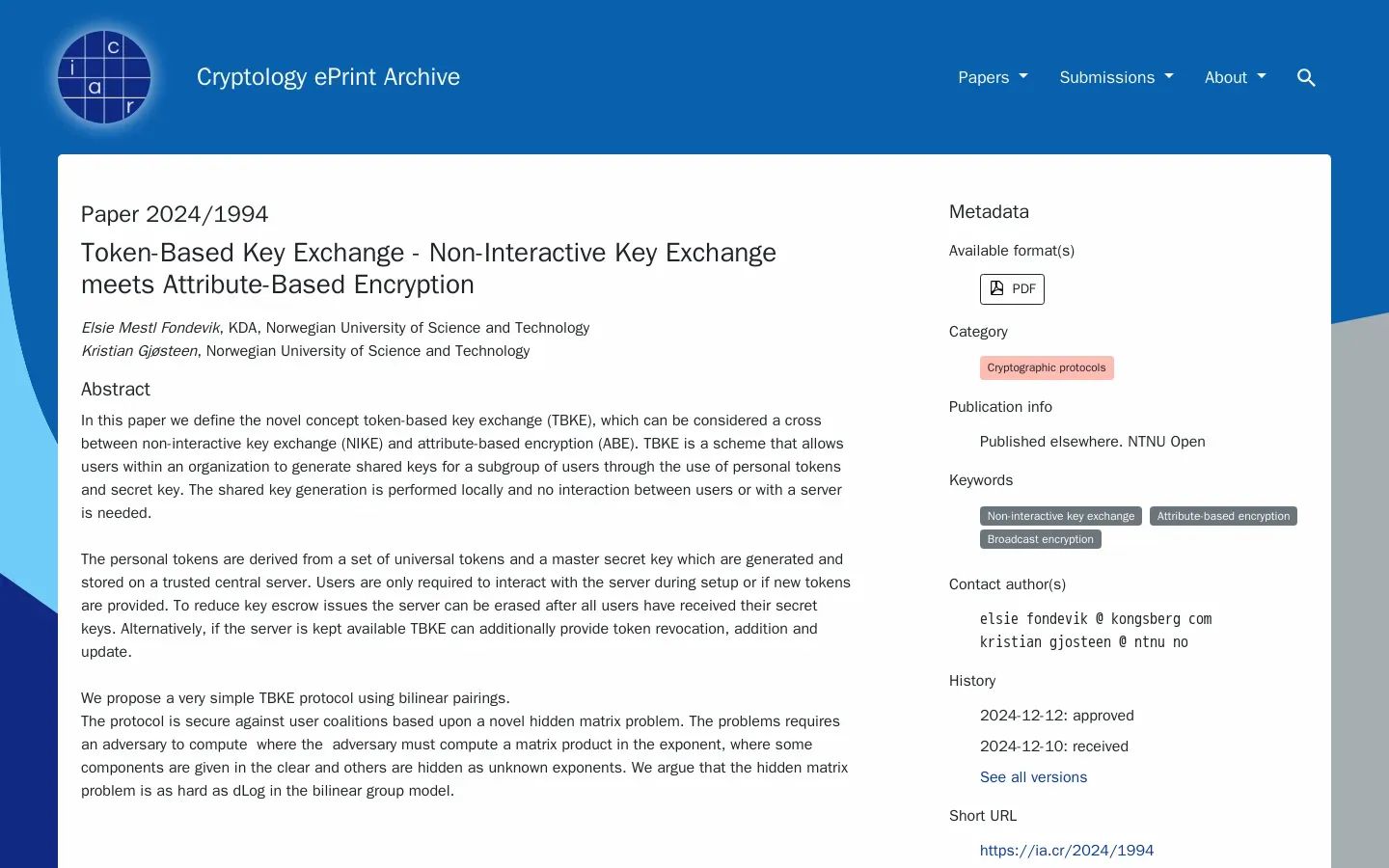
Token-Based Key Exchange Framework Proposed for Cybersecurity
/ 3 min read
Quick take - Kristian Gjøsteen’s research paper on Token-Based Key Exchange (TBKE) presents a framework aimed at improving cybersecurity through enhanced token generation, local key derivation, and dynamic access control mechanisms, while also addressing challenges related to security models and insider threats.
Fast Facts
- Kristian Gjøsteen’s research introduces Token-Based Key Exchange (TBKE), enhancing secure communication and access control in cybersecurity.
- Key objectives include robust token generation, local key derivation, addressing security models, and dynamic token management.
- TBKE improves access control, reduces centralized vulnerabilities, and strengthens defenses against insider threats, aligning with zero-trust architectures.
- The study highlights strengths in integrating TBKE with existing frameworks but notes limitations in real-world validation and scalability.
- Future applications of TBKE include enhancing cloud security, securing IoT communications, facilitating multi-organization collaborations, and integrating with blockchain technology.
Advancements in Token-Based Key Exchange: A New Frontier in Cybersecurity
In a notable development within the cybersecurity realm, Kristian Gjøsteen’s research paper, “Token-Based Key Exchange - Non-Interactive Key Exchange meets Attribute-Based Encryption,” introduces an innovative framework poised to reshape secure communication and access control. This study delves into the intricacies of Token-Based Key Exchange (TBKE), offering insights that could redefine modern cybersecurity practices.
Core Objectives of TBKE
Gjøsteen’s research outlines several pivotal objectives that form the backbone of TBKE:
- Token Generation and Setup: The study proposes a robust framework for generating and managing cryptographic tokens, essential for secure exchanges.
- Local Key Derivation: It emphasizes methods for deriving cryptographic keys in localized settings, which enhances both efficiency and security.
- Security Model and Hidden Matrix Problem: The research tackles complex challenges related to security models and the hidden matrix problem, crucial for maintaining data integrity.
- Dynamic Features and Token Management: It introduces dynamic features for real-time token management, adapting to evolving security needs.
Implications for Cybersecurity Practices
The findings from Gjøsteen’s study highlight the transformative potential of TBKE in cybersecurity:
- Enhanced Access Control Mechanisms: TBKE enables more granular access controls, allowing organizations to tailor permissions based on specific attributes, thereby bolstering security.
- Reduction of Centralized Vulnerabilities: By decentralizing key management, TBKE mitigates risks associated with centralized vulnerabilities, making systems less appealing targets for cyber attacks.
- Resilience Against Insider Threats: The framework enhances defenses against insider threats by continuously managing access through real-time data and user behavior analysis.
- Support for Zero-Trust Architectures: TBKE aligns with zero-trust security models, which require verification at every stage of digital interactions, assuming threats could be internal or external.
Strengths and Limitations
Gjøsteen’s research is commendable for its comprehensive integration of TBKE with existing cybersecurity frameworks. However, it also acknowledges certain limitations:
- Need for Real-World Validation: Further testing in practical applications is necessary to confirm the framework’s effectiveness.
- Scalability Challenges: Potential scalability issues need exploration to ensure TBKE can be applied across diverse environments.
Future Directions in Cybersecurity
The study opens several promising avenues for future exploration:
- Dynamic Access Control in Cloud Environments: Implementing TBKE could enhance security protocols in cloud computing by providing tailored access controls.
- Secure Communication in IoT Networks: Adapting the framework for IoT devices could ensure secure communication in increasingly interconnected environments.
- Collaboration in Multi-Organization Environments: TBKE can facilitate secure collaborations across different organizations by enabling shared yet controlled access to resources.
- Integration with Blockchain Technology: Leveraging blockchain properties could further enhance the security and reliability of TBKE implementations.
Gjøsteen’s research on Token-Based Key Exchange offers a forward-looking perspective on enhancing cybersecurity through innovative mechanisms. By addressing key challenges and proposing practical solutions, TBKE stands to significantly improve secure communication and access control across various digital landscapes. As the cybersecurity community continues to explore these advancements, stakeholders must consider how best to integrate these findings into existing systems to maximize their potential benefits.



